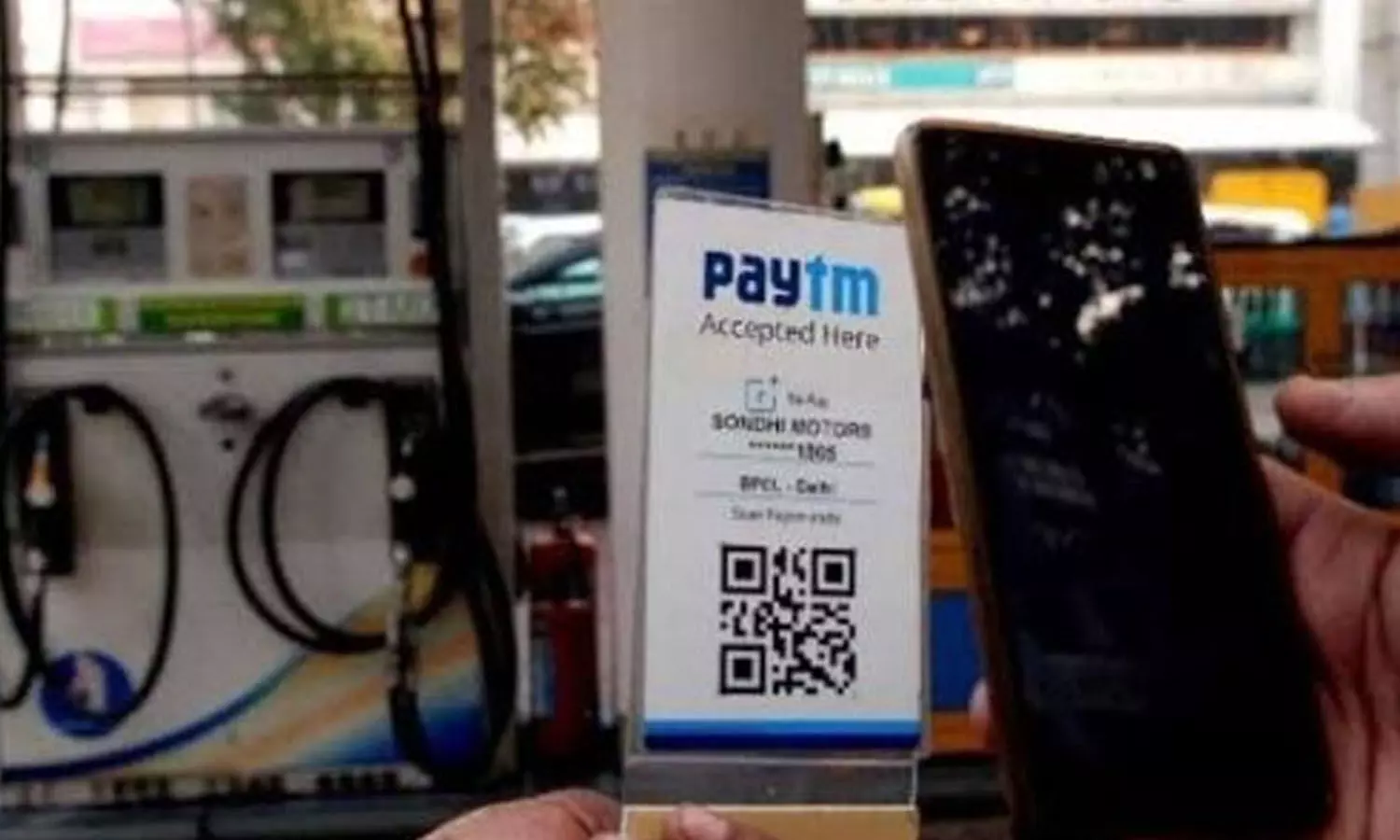UPI transactions will pinch your pocket; NCPI, PayTM gave only half truths
The catch here is that both the NPCI and the PayTM, in their clarifications in the last few days, have only told half the truth while concealing the rest

HYDERABAD: The Unified Payments Interface (UPI) transactions which have been offered for free till now, will pinch you in your pocket everytime you make payments over Rs 2,000 through UPI, using the digital wallets. The catch here is that both the National Payments Corporation of India (NPCI) and the PayTM, in their clarifications in the last few days, have only told half the truth while concealing the rest.
The clarification by the NPCI on the 1.1 percent interchange fee on UPI transactions appears to have added more knots to the prevailing confusion. The broader message is about the levying of charges on payments made through Prepaid Payments Instruments (PPIs) or, in simple terms, the digital wallets like the PayTM, on transactions of Rs 2,000 and more. The charges will be levied effective April 1, 2023.
Let’s dig into the past a bit to know how we have been smartly coaxed into the habit of digital payments. Remember what Prime Minister Narendra Modi said at the time of thrusting the digital payments on the country? It was popularised then that the digital mode would help bring down cash transactions and the usage of hard currency. But in reality, the use of currency has only increased multifold as compared to the past after the introduction of UPI payments.
It is also a fact that the Narendra Modi government categorically stated in the past that the UPI payments are completely free of charge. But within a few years, the Union government is giving a completely different spin to it to infuse charges into the digital mode that was offered for free. The digital payments in the country have now risen to a staggering eight billion (800 crore) transactions per month. The NPCI and the Centre claim that processing these many transactions every month is putting an enormous burden on the banks and the PPIs or the wallet firms.
Using this as a ruse, it was announced that an interchange fee of 1.1 percent would be levied on the digital transactions of Rs 2,000 and above, in an attempt to offset this burden. One needs to under the smart play here that works more like ‘slow poison’. No ordinary individual really craved for the UPI transactions until they were imposed on the country by the Union Government. After offering them for free in the initial years, it is again the Union Government that has taken a complete U-turn to levy charges on digital transactions under the garb of unwieldy maintenance costs. And the move comes even after the Centre reassured a few months back that there won’t be any charges levied on the digital payments.
What was the motive for the Centre’s volte face on digital transactions and for whose benefit? The timing of the move is also giving rise to premonitions on whether it was intended to bail out PayTM whose share price has plummeted drastically in the Indian stock market in the recent past. From around Rs 2,000 not so long ago, PayTM saw its stock falling down to one fourth of it now. The anecdotal reference of PayTM’s stock market woes may seem a bit out of context here. But the clarifications issued both by the NPCI and PayTM on the interchange fee for digital payments lack key information and thus ignite these apprehensions.
The NPCI asserts that there would not be any significant impact on the common user with the levying of the 1.1 percent interchange fee only on digital transactions of Rs 2,000 and above. The ground reality is, the middle class and those from the lower strata of life are already reeling under a steep price rise in almost all essential commodities, with no signs of respite in the near future. Right from groceries, vegetables and cooking gas to diesel and petrol, the prices have skyrocketed, making them unaffordable for the common man. The assumption that the ordinary public would not be spending above Rs 2,000 at a time appears foolhardy in nature.
Also, the NPCI is more concealing than revealing with regard to the ambiguity over the interchange fee and other intricacies involved in it. For example, if a customer’s UPI wallet – be it PhonePe, Google Pay, PayTM or BHIM – is linked to his or her bank account, then the transaction money will be directly transferred from it without any charge. This happens only when the recipient’s wallet is also linked to their bank account. But if the recipient wallet is not linked to the bank account and a transaction of Rs 2,000 or more is made to the wallet, then such recipient UPI will have to pay the interchange fee to the paying bank.
Assume you have an account with SBI and are registered with PayTM for UPI payments. Imagine you have recharged your PayTM account with Rs 5,000 by directly withdrawing the money from your bank account. PayTM, in such a case, claims that you don’t have to pay a single rupee to it even as the bank charges the interchange fee for the purpose. PayTM deliberately suppresses the information on the bank charges here. Instead, it says that the wallet does not charge anything from the customer. Why does the wallet firm stop short of emphatically stating that there will be no charges even at the bank’s end?
PayTM, which is already staring down the barrel amid steep losses, is supposed to entirely bear this fee which was determined as 15 basis points. With a customer base of over 10 crores, how would it gulp down the interchange fees of all their transactions above Rs 2,000? Isn’t it logical to anticipate that the wallet firm will eventually shift this burden on to its customers in some form or the other? This is the clarity that was glaringly missing from PayTM’s clarification on the new regime of interchange fees.
Here is one more example from another extreme. Take the case of a small-time vendor of mobile phones who has an account with SBI and a QR Code linked to it. If a customer uses PayTM wallet to transfer Rs 2,000 or more to the vendor, then his bank SBI will pay his digital wallet firm the 1.1 percent interchange fee. How do you think SBI will deal with the absorption of these fees due to the digital payments? Will the bank squeeze this amount from the account holder? If so, through direct means or through indirect taxing? Will it be collected individually for each transaction? Or in a cumulative form on a monthly or quarterly basis? With no clarity on these pertinent queries, the ambiguity reigns supreme here.
Below is the list of sector-wise details of interchange charges:
A 0.7 percent fee will be levied for mobile phone recharging or other related mobile services with no upper ceiling prescribed to it.
For utilities and post office services, the fee is 0.7 percent with no upper ceiling.
For schools and colleges, the fee is the same as 0.7 percent with the maximum fee capped at Rs 15.
For government services, one percent fee will be levied and the maximum fee limit is Rs 10.
For supermarkets, it is 0.9 percent with no upper ceiling set.
For petrol, diesel, LPG and CNG, the fee is set at 0.5 percent with no maximum fee cap.
For Insurance, 1 percent fee with a maximum fee of Rs 10.
Transactions for Railways will attract 1 percent interchange fee and the maximum fee limit is set at Rs 5.
For agriculture, the fee will be 0.7 percent, maximum fee cap is determined at Rs 10.
For kirana or convenience stores, the fee is 1.1 percent with no upper ceiling on it.
A detailed look and assimilation of the charges structure will make one wonder if the Centre has introduced the digital payments regime to actually benefit the public or to simply do business in disguise.
Presuming there are about 100 crore transactions above Rs 2,000 out of a total of 800 crores in a month, a minimum of Rs 1,000 crores will be exchanged in a month in the form of these fees. It is anybody’s guess as to who will end up coughing up this money. It is the customer, who is the end user. It would only be wishful thinking to expect the Centre to come up with a legislation and make the banks and wallet firms bear these fees and thus save the customer from this burden. Even if there is one such move, the advisory to that effect may simply end up with mere lip-service.



